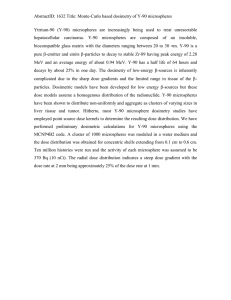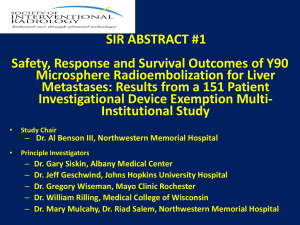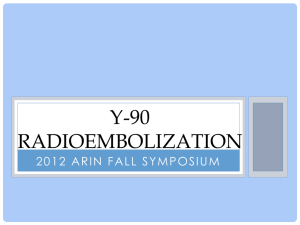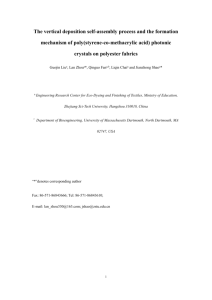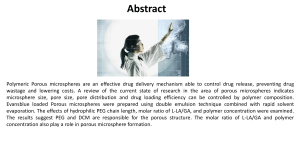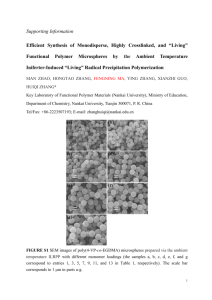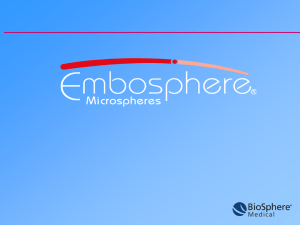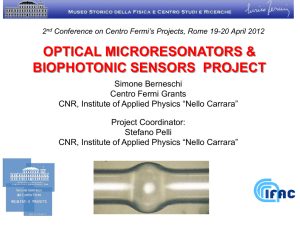Prostate Brachytherapy Lessons Learned July 26, 2012
advertisement
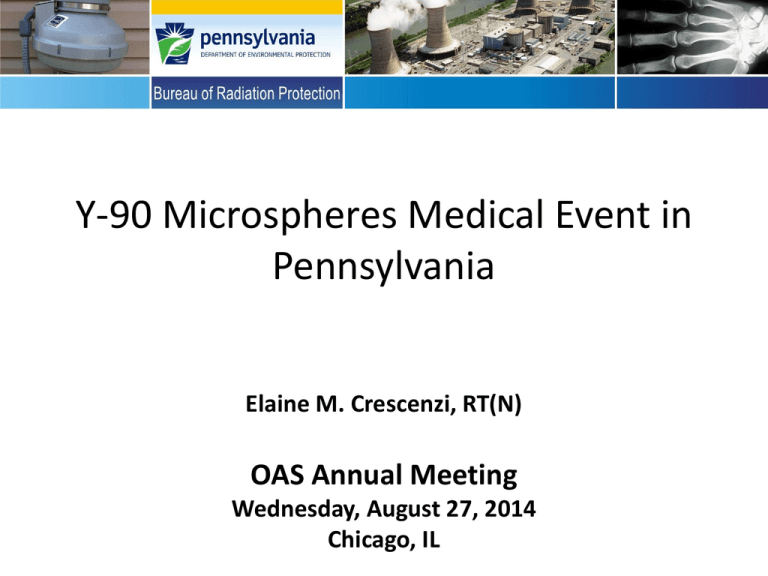
Y-90 Microspheres Medical Event in Pennsylvania Elaine M. Crescenzi, RT(N) OAS Annual Meeting Wednesday, August 27, 2014 Chicago, IL Today’s Presentation • Describe a medical event in Pennsylvania that involved gastrointestinal shunting of Y-90 microspheres that resulted in a bleeding ulcer and severe anemia • Discuss issues raised by this event Microspheres Brachytherapy • Treatment of unresectable tumors in the liver • Normal liver tissue is primarily supplied by the portal vein; liver tumors are primarily supplied by the hepatic artery. Y-90 microspheres are injected into the hepatic artery of the liver through a catheter. • The microspheres flow into the liver tumor and become permanently lodged in its blood vessels. The beta radiation destroys the tumor cells from within the tumor, which reduces the impact to the surrounding healthy liver tissue. NRC Guidance for Microspheres • “For the purpose of written directives and medical event reporting requirements in the Y-90 microsphere guidance, ‘prescribed dose’ means the total dose (rad or Gy). Alternatively, prescribed activity (mCi or GBq) may be used in lieu of prescribed dose.” • “The written directive should specify the maximum dose(s)/activity(ies) that would be acceptable to the specified site(s) outside the primary treatment site due to shunting (e.g. lung and gastrointestinal tract).” • “The licensee shall record the administered dose/activity delivered to the primary treatment site and to other specified site(s)…” NRC Guidance for Microspheres The licensee shall commit to report any event, except for an event that results from intervention of a patient or human research subject, in which: 1) the administration … of the wrong radionuclide 2) the administration of Y-90 microspheres results in a dose a) that differs from the prescribed dose … by 20 percent b) … to the wrong individual, via the wrong route, or by the wrong mode of treatment; or c) to an organ or tissue other than the treatment site that exceeds by 0.5 Sv (50 rem) to an organ or tissue and by 50 percent or more of the prescribed dose/activity expected to that site from the administration of Y-90 microspheres, if carried out as specified in the written directive. Medical Event Reported to PA • A patient had a treatment of 36 mCi of Y-90 on 8/15/2013 for tumors in the left lobe of her liver • She developed ulcer symptoms and was treated on 9/6/2013 • She received two individual treatments of approximately 5 mCi of Y-90 each on 10/10/2013 for two different locations in her right liver lobe • Treatment for severe anemia was initiated on 2/26/2014. An endoscopy indicated an ulcer in her duodenum. A biopsy sample of the ulcer contained 55-60 synthetic beads Medical Event Reported to PA • On 3/10/2014, the licensee reported this event by telephone to Pennsylvania • On 3/11/2014, the state performed a reactive inspection • No violations were identified • Coordinated with Ohio to determine how they handled similar events • Coordinated with NRC to evaluate similar events in NMED Issues Identified from this Event • If an ulcer is found in the GI tract, and microspheres are inside, what is the likely dose to the unintended organ? Greater than 50 rem? • Is GI shunting an accepted risk of this procedure? Should these incidents, when they occur, be considered medical events? Questions • What have your licensees been reporting? • What have your inspections been finding? • What do your inspectors emphasize during microspheres inspections? • Do your licensees perform imaging to prevent and evaluate GI shunting? Elaine Crescenzi, RT(N) DEP Radiation Health Physicist ecrescenzi@pa.gov www.dep.state.pa.us 484-250-5835
